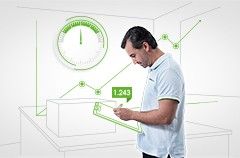Además de nuestro soporte técnico telefónico ininterrumpido actual, ofrecemos lo último en soporte técnico remoto mediante tecnología de realidad aumentada (RA). Esto nos permite seguir ofreciendo el soporte rápido de expertos que necesita para lograr sus objetivos de productividad.
Nuestra solución de asistencia remota visual con realidad aumentada de METTLER TOLEDO nos ayuda a entender por completo sus problemas de servicio técnico. El uso de un dispositivo móvil con una cámara integrada nos permite ver lo mismo que usted. Podemos guiarle paso a paso para resolver el problema ofreciéndole asistencia contextual en tiempo real, como añadir texto, dibujos o resaltar objetos con marcadores en 3D. Benefíciese del soporte más rápido de diagnóstico de fallos, reparación y sustitución de piezas con el uso de la tecnología más reciente. Podemos conectarnos de forma remota a algunos de nuestros productos para conseguir unas mejoras adicionales del servicio. Póngase en contacto con su equipo de servicio técnico local para obtener más información.















